The Wishing Well Cluster (NGC 3532) is a bright open cluster located approximately 1,321 light-years away in the southern constellation Carina. It has an apparent magnitude of 3 and is one of the finest telescope targets in the southern sky.
NGC 3532 is also known as the Pincushion Cluster, the Football Cluster, the Firefly Party Cluster, and the Black Arrow Cluster. The appearance of the cluster has been compared to scattered silver coins in a well, an American football ball, and fireflies having a party.
With an apparent magnitude of 3 and an angular size of 64.3 arcminutes – about twice the size of the full Moon – the Wishing Well Cluster is easily observed in binoculars and small telescopes. It is catalogued as Caldwell 91 (C91) in the Caldwell catalogue of deep sky objects visible in amateur telescopes.
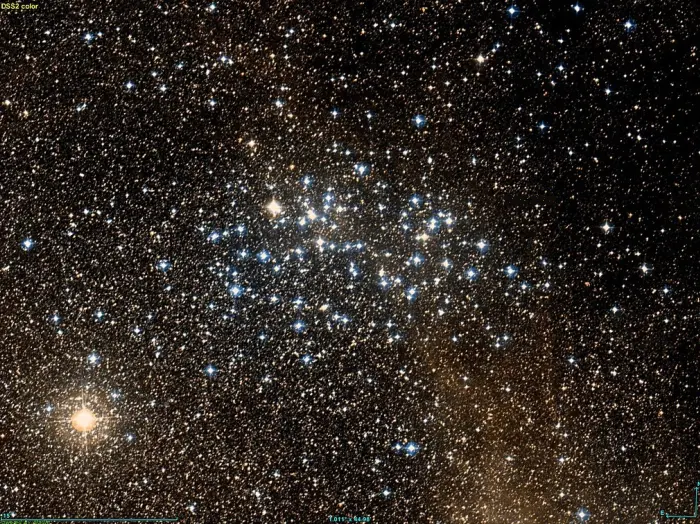
The Wishing Well Cluster (Caldwell 91). Image created using the Aladin Sky Atlas software from the Strasbourg Astronomical Data Center and DSS (Digitized Sky Survey) data. DSS is one of the programs of STScI (Space Telescope Science Institute). Credit: Donald Pelletier (CC BY-SA 4.0)
The cluster is composed of about 400 stars, many of which are binary stars. The brightest members are seventh-magnitude stars. The estimated age of C91 is about 300 million years, making it middle-aged compared to other open star clusters. Astronomers have detected seven red giants and seven white dwarfs in the cluster.
The members of the cluster that started their lives with moderate masses appear as bright blue stars, while the more massive stars have already burned through their supplies of hydrogen fuel and evolved away from the main sequence to become red giant stars.
The most massive stars of the open cluster have already ended their lives as supernovae millions of years ago, while lower mass stars, which have longer lives, still shine with red or yellow colours.
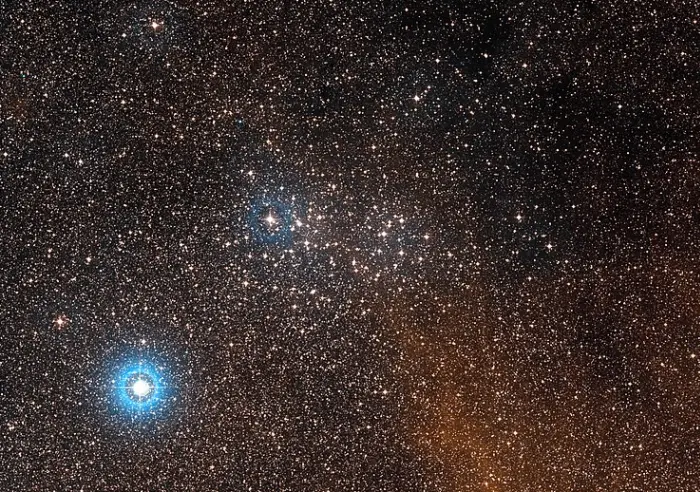
The Wishing Well Cluster, image credit: ESO/Digitized Sky Survey 2 (DSS2) (CC BY-SA 4.0)
Facts
The Wishing Well Cluster was discovered by the French astronomer Nicolas Louis de Lacaille in January 1752. Lacaille included the object in his 1755 catalogue as Class II No. 10 (Lac II.10). He described it as a “prodigal cluster of small stars, very compressed, filling the figure of a semi-circle of 20 to 25 minutes in diameter.”
Scottish astronomer James Dunlop observed the cluster in a 9-inch telescope from New South Wales and listed it as No. 323 in his 1827 catalogue. He described it as a “a very large cluster of stars about the 9th magnitude, with a red star of the 7-8th magnitude, north following the centre of the cluster. Elliptical figure: the stars are pretty regularly scattered.”
The 19th-century English astronomer John Herschel considered the Wishing Well Cluster to be one of the finest open clusters in the sky, a binary-rich cluster with “several elegant double stars.” He observed the cluster in an 18-inch telescope from the Cape of Good Hope in South Africa in the 1830s and noted, “A glorious cluster of immense magnitude, being at least 2 fields in extent every way. The stars are 8, 9, 10 and 11 mag, but chiefly 10th magnitude, of which there must be at least 200. It is the most brilliant object of the kind I have ever seen.”
The Wishing Well Cluster was the first target of NASA and ESA’s Hubble Space Telescope. Hubble was designed in the 1970s and 1980s and launched on April 24, 1990. It observed the cluster on May 20, 1990. The first image was taken with the Wide Field and Planetary Camera, and it showed a region near the hot blue-white star HD 96755, a member of the cluster. The “first light” image helped with focusing the telescope.
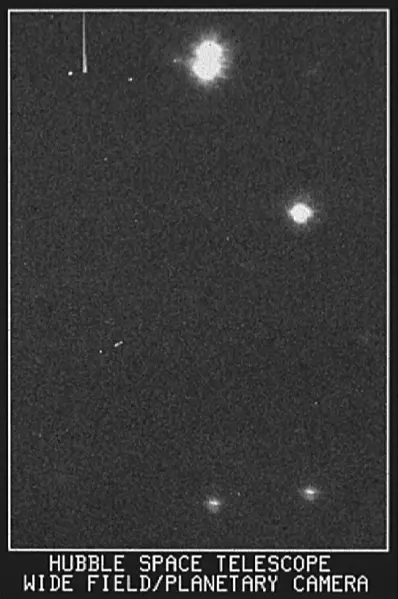
This image is part of the first image taken with NASA’s Hubble Space Telescope’s (HST) Wide Field/Planetary Camera. All objects seen are stars within open cluster NGC 3532 in the Milky Way galaxy. Stars pictured in the HST frame are sharper than ground telescope images and well resolved, as shown by the double star at the top of the image. By avoiding the Earth’s atmosphere, the HST gives sharper images and better resolution. In this early engineering picture, the HST images are roughly 50 percent sharper than the ground-based images. Credit: NASA, ESA, and STScI
The Wishing Well Cluster was imaged with the Long Range Reconnaissance Imager (LORRI), a telescopic camera aboard the New Horizons interplanetary space probe, on December 5, 2017. The image broke the distance record for an image taken at the greatest distance from Earth.
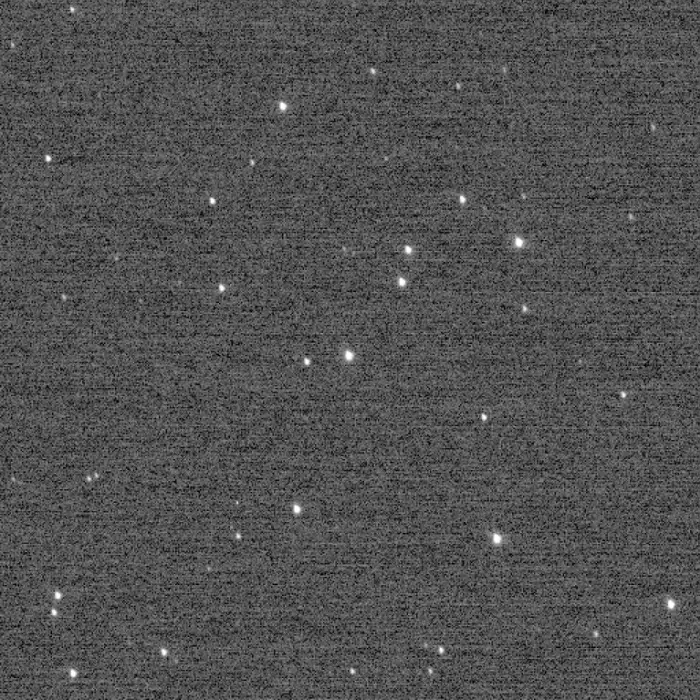
For a short time, this New Horizons Long Range Reconnaissance Imager (LORRI) frame of the “Wishing Well” star cluster, taken Dec. 5, 2017, was the farthest image ever made by a spacecraft, breaking a 27-year record set by Voyager 1. About two hours later, New Horizons later broke the record again. Image credit: NASA/Johns Hopkins University Applied Physics Laboratory/Southwest Research Institute
The Wishing Well Cluster was imaged from the European Southern Observatory’s (ESO) La Silla Observatory in Chile in 2014. Released in November 2014, the image revealed the cluster’s blue, red, and orange stars standing out against a rich field of the Milky Way.
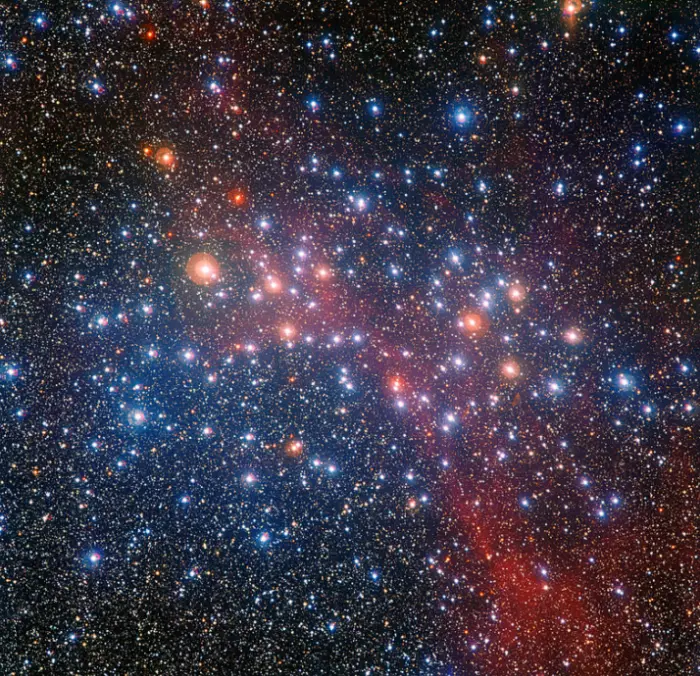
The MPG/ESO 2.2-metre telescope at ESO’s La Silla Observatory in Chile captured this richly colourful view of the bright star cluster NGC 3532. Some of the stars still shine with a hot bluish colour, but many of the more massive ones have become red giants and glow with a rich orange hue. Image credit: European Southern Observatory (ESO)/G. Beccari (CC BY 4.0)
The yellow hypergiant V382 Carinae (x Carinae) appears in the same line of sight as the cluster. With an apparent magnitude of 3.93, the star is visible to the unaided eye on a clear night. It appears near the southeastern corner of the cluster, but is not a member. The hypergiant star lies approximately 6,200 light-years away, while the cluster is much closer to us at 1,321 light-years.
Location
The Wishing Well Cluster is located in the constellation Carina. It lies in the southeastern part of the constellation, in the area of the sky near the Diamond Cross, between the Southern Cross and the False Cross.
Formed by Miaplacidus (Beta Carinae) with Theta, Omega, and Upsilon Carinae, the Diamond Cross is one of three diamond-shaped asterisms in the far southern sky. It appears between the more conspicuous Southern Cross in the constellation Crux and the False Cross in Vela and Carina. Miaplacidus, the brightest star in the asterism, is the second brightest star in Carina, after Canopus.
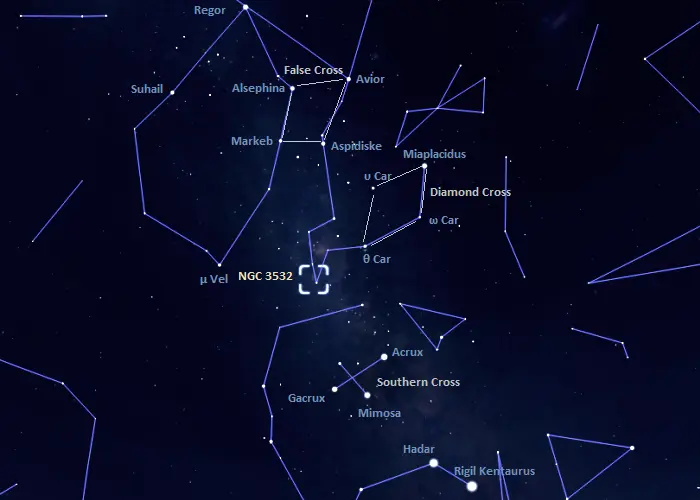
The location of the Wishing Well Cluster, image: Stellarium
The Wishing Well Cluster can be found using the bright stars of Carina, Centaurus, and Crux. It appears near the intersection of the imaginary lines extended from Omega through Theta Carinae in the Diamond Cross and from Rigil Kentaurus, the third brightest star in the sky, through Acrux in the Southern Cross. A line through the beam of the Southern Cross, extended from Mimosa (Beta Crucis) through Imai (Delta Crucis), passes just north of the cluster.
The cluster is visible from locations south of the latitude 30° N. It never rises high above the horizon for observers in the northern hemisphere. Observers in the southern hemisphere can see the cluster throughout the year.
The Wishing Well Cluster is visible to the unaided eye, appearing as a bright patch within the Milky Way. The brightest stars in the cluster can be resolved with binoculars and small telescopes. NGC 3532 is best observed at low magnification. A wide field view of the cluster reveals several dark lanes dividing the stars in the cluster and blocking the view of more distant stars.
The Wishing Well Cluster appears in a rich part of the Milky Way and stands out against the background sky, which is crowded with stars. It lies in the same area as the famous Carina Nebula (NGC 3372), the Theta Carinae Cluster (IC 2602), the Running Chicken Nebula (IC 2948), and the Statue of Liberty Nebula (NGC 3576).
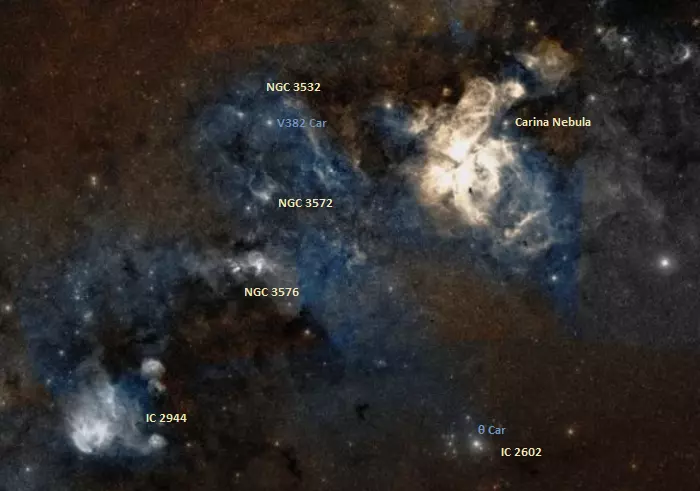
The Wishing Well Cluster, the Carina Nebula, the Theta Carinae Cluster, the Statue of Liberty Nebula and the
Running Chicken Nebula, image: Wikisky
The Carina Nebula is one of the largest nebulae in the sky. With an apparent magnitude of 1.0 and an apparent size of 6 arcminutes, the nebula is visible to the unaided eye on a clear night. It contains some of the most massive and luminous stars known, including the luminous blue variable Eta Carinae.
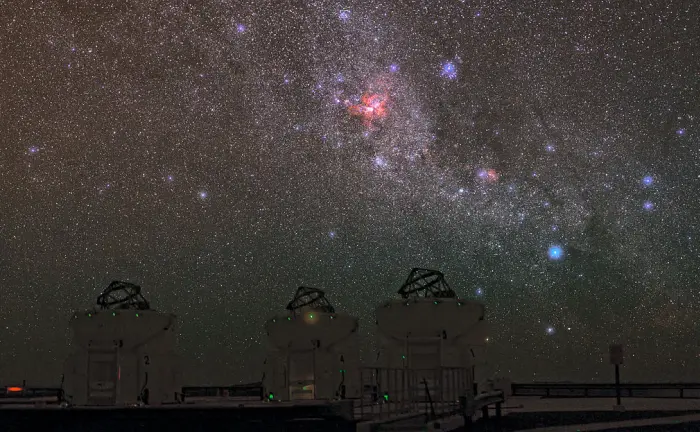
ESO Photo Ambassador, Babak Tafreshi has captured an outstanding image of the sky over ESO’s Paranal Observatory, with a treasury of deep-sky objects. The most obvious of these is the Carina Nebula, glowing intensely red in the middle of the image. The Carina Nebula lies in the constellation of Carina (the Keel), about 7500 light-years from Earth. This cloud of glowing gas and dust is the brightest nebula in the sky and contains several of the brightest and most massive stars known in the Milky Way, such as Eta Carinae. Below the Carina Nebula, we see the Wishing Well Cluster (NGC 3532). This open cluster of young stars was named because, through a telescope’s eyepiece, it looks like a handful of silver coins twinkling at the bottom of a wishing well. Further to the right, we find the Lambda Centauri Nebula (IC 2944), a cloud of glowing hydrogen and newborn stars which is sometimes nicknamed the Running Chicken Nebula, from a bird-like shape that some people see in its brightest region. Above this nebula and slightly to the left we find the Southern Pleiades (IC 2602), an open cluster of stars that is similar to its more familiar northern namesake. In the foreground, we see three of the four Auxiliary Telescopes (ATs) of the Very Large Telescope Interferometer (VLTI). Image credit: ESO/B. Tafreshi (twanight.org) (CC BY 4.0)
Nicknamed the Southern Pleiades, the Theta Carinae Cluster is a bright open star cluster located 486 light-years away. With a visual magnitude of 1.9, it is easily visible without binoculars. The hot blue star Theta Carinae, the brightest star in the cluster, shines at magnitude 2.76 and marks the northeastern vertex of the Diamond Cross.
The Running Chicken Nebula (or the Lambda Centauri Nebula) is an emission nebula associated with a young open cluster, located in the constellation Centaurus. It has an apparent magnitude of 4.5 and an apparent size of 75 arcminutes. It lies 6,500 light-years away.
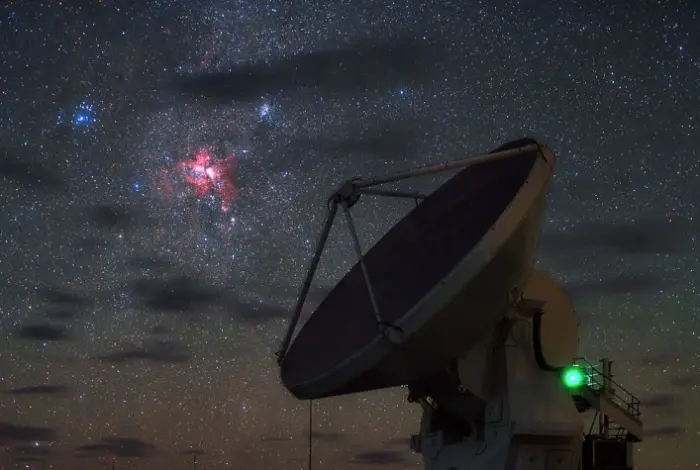
In this wonderful high definition, singe-exposure image taken during the ESO Ultra HD Expedition, three deep sky objects seem to shine in front of the dish of one of the Atacama Large Millimeter/submillimeter Array (ALMA) high-precision antennas. The most striking feature is the reddish Carina Nebula, also known as NGC 3372. It is a large cloud of gas, mostly hydrogen, in which star formation has recently taken place. The short-lived massive blue stars forged within the nebula emit copious amounts of ultraviolet radiation, which then ionises the surrounding gas and causes the hydrogen atoms to glow with a characteristic red colour. Eventually supernova events and strong stellar winds from the most massive stars will disperse the gas of the Carina Nebula, leaving behind one or more clusters of stars. Two such star clusters, known as NGC 3532 and IC 2602, can be seen respectively to the top right and top left of the Carina Nebula in this image. The three celestial objects belong to the constellation of Carina (the Keel) and were first catalogued by the French astronomer Nicolas Louis de Lacaille. They look close to one another in this image, but actually their distances from us are very different. IC 2602 lies less than 500 light-years from Earth, NGC 3532 is around 1300 light-years away and the Carina Nebula is thought to lie up to 10 000 light-years away. Image credit: ESO/B. Tafreshi (CC BY 4.0)
The Statue of Liberty Nebula is a bright emission nebula about 100 light-years across, located 6,000 light-years away. The nickname refers to the distinctive shape in the central portion of the nebula.
The best time of the year to observe the Wishing Well Cluster and other deep sky objects in Carina is during the month of March, when the constellation is higher above the horizon in the evening.
Wishing Well Cluster – NGC 3532
| Constellation | Carina |
| Right ascension | 11h 05m 40.1s |
| Declination | −58° 42.25′ |
| Apparent magnitude | 3 |
| Apparent size | 64.3 arcminutes |
| Distance | 1,321 light-years (405 parsecs) |
| Age | 300 million years |
| Names and designations | Wishing Well Cluster, Pincushion Cluster, Football Cluster, Firefly Party Cluster, Black Arrow Cluster, NGC 3532, Caldwell 91, Melotte 103, Collinder 238, C 1104-584, CL 1104-584, Cl* 1104-584, Lacaille II.10, Theia 720, MWSC 1890, OCl 839.0 |